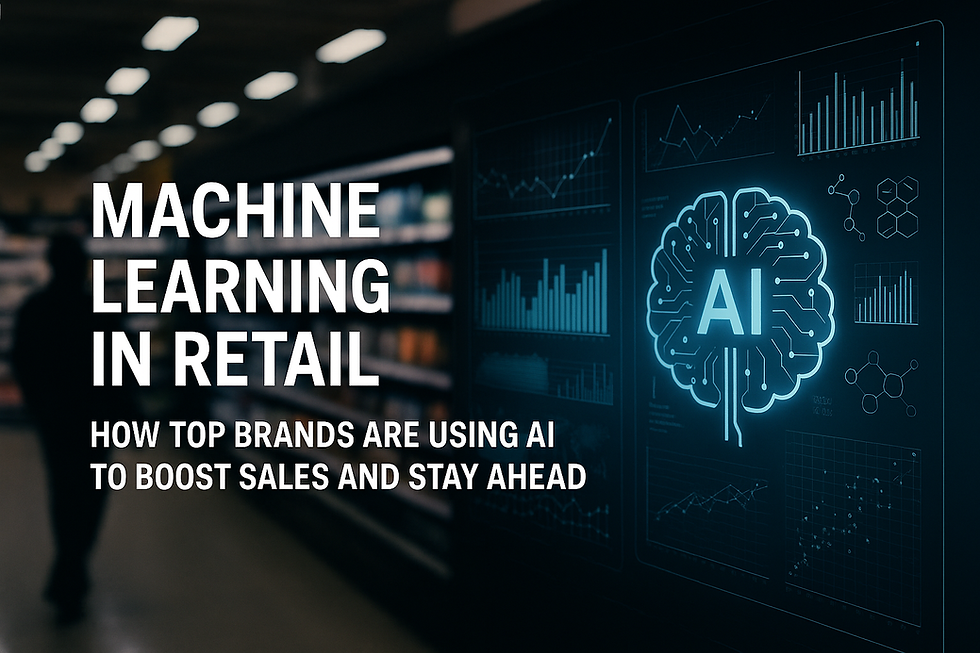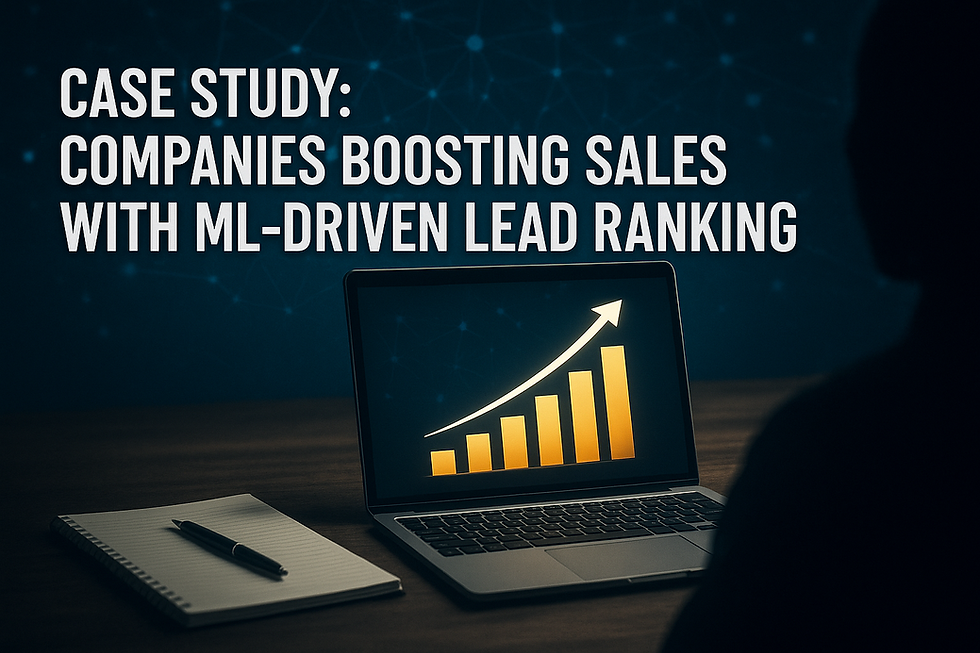Machine Learning in Retail: How Top Brands Are Using AI to Boost Sales and Stay Ahead
- Muiz As-Siddeeqi

- Sep 15
- 5 min read
Updated: Sep 15

Machine Learning in Retail: How Top Brands Are Using AI to Boost Sales and Stay Ahead
Machine Learning in Retail: How Top Brands Are Using AI to Boost Sales and Stay Ahead
They’re not just selling anymore.
They’re predicting. Personalizing. Automating. Optimizing. In real-time.
And we’re not talking about some future fantasy. We’re talking about what's happening right now — in the very aisles you shop, apps you scroll, and emails you receive. It’s machine learning, and it’s quietly—but massively—redefining how the world’s top retail brands operate, compete, and win.
This isn’t just digital transformation. This is retail warfare at algorithmic scale.
And the winners?
They're not the ones shouting the loudest. They're the ones learning the fastest.
Let’s unpack, with real numbers, real names, and real results — how machine learning is driving the next era of retail sales strategy across the biggest brands you know.
Bonus: Machine Learning in Sales: The Ultimate Guide to Transforming Revenue with Real-Time Intelligence
The Quiet Algorithmic Revolution Happening on Store Shelves
Imagine this.
You're in a Walmart store. The cereal shelf looks perfectly stocked. The discounts seem just right. The lighting feels ideal. And somehow, they knew you might grab that oat milk, didn’t they?
That experience was not a happy accident. It was likely shaped by deep neural networks crunching data across millions of transactions, store cameras analyzing shopper movements, and real-time forecasts balancing inventory vs. demand across 4,700+ locations.
This is the machine learning retail sales strategy in action.
Real Stat
Walmart processes over 2.5 petabytes of data every hour across stores, eCommerce, and logistics — all used to train ML models for stocking, pricing, demand planning, and more.
Source: Forbes Tech Council, 2022
Case Study: Walmart’s Intelligent Retail Lab (IRL)
Walmart didn’t just sprinkle ML across a few dashboards.
They built a full-blown AI-powered store in Levittown, NY called the Intelligent Retail Lab (IRL) — a 50,000 square foot experimental location where shelf cameras, sensors, and ML systems analyze product availability, checkout traffic, and floor cleanliness in real-time.
Here’s what they did:
Shelf intelligence: ML models flag when items run out on shelves or misplaced.
Camera-based alerts: Models detect long checkout lines and prompt management to open new registers.
Privacy-first: No facial recognition or PII collection.
And the result?
→ Real-time decision-making that increased product availability and optimized labor hours.
→ Faster response to out-of-stock alerts.
→ Customers stayed longer and returned more often.
Source: Walmart IRL Launch Report, 2019
Target’s Secret Weapon: AI-Powered Inventory Optimization
Let’s move to Target — another titan, but with a slightly different flavor.
Target doesn’t aim to be just reactive — it wants to be proactive. It uses demand forecasting models powered by machine learning to reduce overstocks, understocks, and markdowns.
How Target Uses ML:
Item-level forecasting: ML models predict demand for each SKU, per store, per week.
Weather + Event modeling: If a snowstorm’s expected in Chicago, it adjusts shipments of winter gear days in advance.
Supply chain routing: AI helps decide where to pull inventory from — warehouses, stores, or directly from suppliers.
Real Stat
Between 2019 and 2023, Target reduced out-of-stock rates by 43% in pilot regions using AI-driven demand forecasting.
Source: Target Tech Blog, 2023
And in 2024, they reported a 15% increase in full-price sales and $200 million saved in markdown avoidance.
Amazon: The King of Hyperpersonalization
Amazon isn’t just a retailer — it’s a data company with a checkout button.
Their machine learning strategy goes far beyond recommendation engines. Amazon uses ML in everything from personalized email campaigns to dynamic pricing, warehouse robotics, and Alexa shopping nudges.
Real Case
Product Recommendations: ML models drive 35% of Amazon’s total sales through personalized product suggestions.
Source: McKinsey Digital, 2022
Forecasting Algorithms: Their “anticipatory shipping” patent uses ML to ship products to local warehouses before you even order them — based on your behavior patterns.
Pricing AI: Amazon updates prices every 10 minutes across millions of products using ML models trained on competitor pricing, demand, inventory, and browsing trends.
Sephora: Using ML to Personalize Beauty at Scale
Sephora went beyond just selling makeup — they built a beauty-tech experience using machine learning personalization.
Color IQ system: ML models match skin tones with thousands of product combinations.
AI chatbots: Guide shoppers to right shades, skincare routines, etc.
Client behavior prediction: Their ML model predicts when a shopper might churn or re-order, triggering automated follow-ups.
Real Impact
Their AI-powered personalization strategy led to a 20% lift in conversion rates and 30% improvement in customer retention in 2023.Source: LVMH Group Digital Reports
Home Depot: Predictive ML Meets DIY Retail
Home Depot uses machine learning to do one thing exceptionally well: Forecast what customers will need — before they even visit the store.
Their predictive sales models blend weather data, Google search trends, regional buying behavior, and competitor pricing to stock and price items down to the zip code.
Real Stat
Home Depot reported a 30% increase in online-to-store sales conversion after integrating ML-based inventory forecasting tools across 2000+ stores in 2022.
Source: Home Depot Investor Relations
Real-Time Examples Across Global Retailers
It’s not just U.S. giants — machine learning in retail sales strategy is becoming global best practice.
Alibaba (China)
Uses ML to power its City Brain project, which integrates shopping behavior, logistics, traffic, and footfall data for hyperlocal inventory management across thousands of stores.
Source: Alibaba Cloud AI Whitepaper, 2023
Zara (Spain)
Deploys machine learning to reduce lead time from design to shelf — from industry standard 6 months to just 3 weeks, optimizing style relevance and reducing deadstock.
Source: Inditex Annual Report, 2023
Tesco (UK)
AI-driven Clubcard personalization engine delivers tailored offers per household, driving over 70% redemption rate in campaigns.
Source: Tesco AI & Data Science Insights, 2022
But What About Small Retailers?
The good news?
Machine learning isn’t just for giants. Platforms like Shopify, Square, and Google Retail Cloud are putting pre-trained ML models into the hands of small and mid-sized retailers.
Shopify’s AI tools: Predictive recommendations and demand forecasting.
Google Vertex AI: Plug-and-play models for price optimization and churn prediction.
Square for Retail: Uses ML to suggest when to reorder products and what to upsell at checkout.
Challenges That Still Exist
Let’s be real — it’s not all magic and profits.
Data silos still slow ML training.
Bias in algorithms can lead to unfair pricing.
Privacy regulations like GDPR and CCPA limit behavioral tracking.
Talent shortage of retail-focused ML engineers is real.
And yet, brands pushing through these are already seeing measurable sales impact.
The Future: Autonomous Retail?
The direction is clear. ML is moving retail from reactive to self-driving.
Amazon Go stores are already cashierless.
Ocado in the UK runs robotic grocery fulfillment driven entirely by ML.
Nike is using AI to co-design shoes based on trend data.
Retail isn’t transforming. It’s being reprogrammed.
Final Takeaway
Machine learning in retail sales strategy is no longer a nice-to-have. It’s the difference between surviving and leading.
The top brands — Walmart, Target, Amazon, Sephora, Home Depot — didn’t “adopt” AI. They built around it. They integrated it deep into their retail DNA — in stocking, pricing, personalization, forecasting, and beyond.
And that’s why they’re not guessing their next sale.
They’re predicting it.
And if you’re in retail — big or small — this is your wake-up call to stop thinking of AI as a side project… and start making it your core strategy.

$50
Product Title
Product Details goes here with the simple product description and more information can be seen by clicking the see more button. Product Details goes here with the simple product description and more information can be seen by clicking the see more button

$50
Product Title
Product Details goes here with the simple product description and more information can be seen by clicking the see more button. Product Details goes here with the simple product description and more information can be seen by clicking the see more button.

$50
Product Title
Product Details goes here with the simple product description and more information can be seen by clicking the see more button. Product Details goes here with the simple product description and more information can be seen by clicking the see more button.






Comments